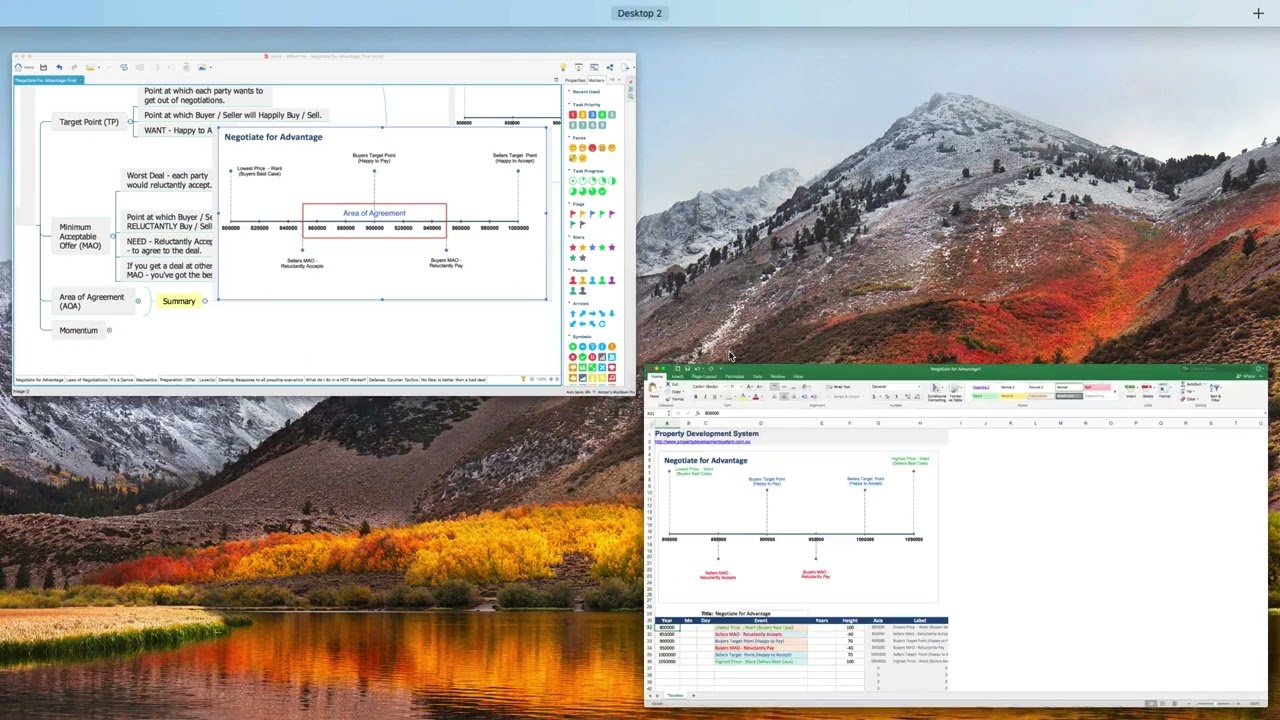Negotiate for Advantage 01
Here is a comprehensive guide to negotiating effectively in business, mainly focusing on real estate deals. It breaks down the process into digestible parts, emphasising preparation, understanding both parties’ minimum acceptable offers (MAO), and strategic interaction during negotiations.
Excel Tool
You will explore an Excel template designed to map out negotiation ranges. This includes setting the lowest price you’re willing to accept and the highest price a seller wants. The tool helps identify both the buyer’s and seller’s minimum acceptable offers, providing a clear visual representation of the negotiation boundaries.
Negotiation Dynamics
The concept of each party’s Target Point and Minimum Acceptable Offer (MAO) is central to the discussion. The Target Point represents the ideal outcome each party aims for, whereas the MAO is the least favourable terms they’re willing to accept. Understanding these points is crucial for effective negotiation, as it helps define the area of potential agreement.
Seller’s Perspective
From a seller’s standpoint, knowing the minimum price they’re willing to accept and aiming for a price that makes them “over the moon” are key aspects. The negotiation space is thus framed by these limits, highlighting the importance of understanding the other party’s expectations and constraints.
Buyer’s Strategy
For buyers, having a clear understanding of one’s own Target Point and MAO is crucial. This involves knowing the maximum you’re willing to pay and the minimum development margin you aim to achieve. Being prepared with this information before entering negotiations can significantly influence the outcome.
Information Gathering
Gather as much information as possible about the other party and the negotiated asset. This includes the seller’s circumstances, market conditions, and any potential issues with the property. Armed with detailed information, a negotiator can better understand leverage points and tailor their strategy accordingly.
Momentum in Negotiations
Highlighting the principle that “an object in motion tends to stay in motion,” the presenter stresses the importance of keeping negotiations moving forward. Avoiding stalls and maintaining engagement are presented as strategies to ensure negotiations progress towards a resolution.
Preparation and Due Diligence
The video emphasises the need for thorough preparation and due diligence. This encompasses understanding market conditions, the property in question, and any factors affecting the negotiation, such as planning issues or the vendor’s circumstances.
Building Rapport
Establishing trust and rapport with the agent and vendor is a critical factor in negotiations. Strategies such as mirroring language and behaviour are suggested to foster a positive negotiation environment.
Insights based on numbers
- Demonstrating with an Excel tool, the importance of quantifying negotiation parameters like the Target Point and MAO is evident. Visualising these numbers can help negotiators understand the acceptable range of offers and strategise accordingly.
- The video uses numerical examples to illustrate the potential development margin a buyer might aim for (e.g., aiming for a 14% development margin but willing to accept a deal at a lower margin if necessary), emphasising the practical application of numbers in negotiation strategy.
Frequently Asked Questions
How can the use of an Excel template improve negotiation outcomes for both buyers and sellers?
Structured Approach
The template provides a structured framework for mapping out the negotiation range, including the lowest price a buyer is willing to pay and the highest price a seller desires. This organisation visualises the negotiation space clearly, helping both parties understand the boundaries of their negotiation.
Quantitative Analysis
It allows for a quantitative analysis of the negotiation parameters, such as the Target Point and Minimum Acceptable Offer (MAO). By inputting these values, parties can see how adjustments to their limits affect the overall negotiation range. This can lead to more informed decision-making.
Scenario Planning
Parties can use the template to simulate various negotiation scenarios, adjusting their target and minimum acceptable offers based on different conditions. This preparation can make negotiators more adaptable and strategic during actual negotiations.
Communication Tool
The Excel tool can be a visual communication tool between negotiating parties, potentially making it easier to explain and justify their positions. While not typically shared directly with the opposing party, it can help a negotiator articulate their stance more clearly.
Record Keeping
Using an Excel template allows for better record-keeping of negotiation parameters and decisions. This historical data can be invaluable for future negotiations, providing insights into what strategies worked and which ones did not.
In what ways does understanding the seller’s circumstances and market conditions influence a buyer’s negotiation strategy?
Tailored Offers
By understanding the seller’s circumstances, such as their reason for selling or any urgency to sell, a buyer can tailor their offer to meet the seller’s needs. For instance, if a seller is looking to liquidate their asset due to financial pressures quickly, a buyer might propose a faster closing with a slightly lower price, making the offer more attractive to the seller.
Leverage Identification
Knowing the market conditions provides insight into who has the upper hand in negotiations. In a buyer’s market, where more properties are available than buyers, a buyer can leverage this situation to negotiate a lower price or better terms. Conversely, understanding that sellers might have multiple offers in a seller’s market allows buyers to adjust their strategy to make their offer stand out.
Strategic Concessions
With detailed information about the seller’s position and market trends, a buyer can identify areas where strategic concessions can be made without compromising their essential goals. This might involve flexibility on non-price terms that are important to the seller, like closing dates or contingencies.
Risk Assessment
Understanding the seller’s circumstances and market conditions aids in assessing the risks involved in the purchase. For example, if the market analysis indicates a declining trend in property values, a buyer might be more cautious with their offer or negotiate terms that mitigate this risk.
Building Rapport
Demonstrating awareness and consideration of the seller’s situation can help build rapport and trust, which are crucial for successful negotiations. Sellers are more likely to engage positively with buyers who understand their needs and constraints.
How does building rapport with an agent or vendor affect the negotiation process and outcomes?
Facilitates Open Communication
Establishing a positive relationship with an agent or vendor opens channels for more honest and forthright communication. With mutual respect and trust, parties are more likely to share important information about their needs, constraints, and preferences. This transparency can lead to finding common ground more quickly and effectively.
Increases Receptiveness to Offers
Agents and vendors who feel a positive connection with a buyer are more inclined to consider their offers seriously. Rapport can make the difference when multiple buyers are involved, as sellers often prefer to negotiate with individuals they like and trust, even if their offers aren’t the highest.
Enhances Negotiation Flexibility
A good rapport can lead to greater flexibility in negotiations. Agents and vendors might be more open to accommodating special requests or concessions when they feel a personal connection. This flexibility can be crucial in finalising a deal that meets the needs of all parties involved.
Aids in Conflict Resolution
Negotiations can sometimes lead to conflicts or misunderstandings. A strong rapport provides a foundation for resolving these issues amicably. When both parties value their relationship, they’re more motivated to find solutions that preserve mutual respect and satisfaction.
Generates Future Opportunities
Beyond the immediate negotiation, a strong rapport with agents and vendors can lead to future business opportunities. Satisfied agents are more likely to recommend you to other sellers, while vendors may prefer to deal directly with you in future transactions, bypassing the competition.
Encourages Better Deals
Rapport can subtly influence the negotiation dynamics, leading to better deals. Agents and vendors who like you may offer more favorable terms, disclose helpful information, or give you the first opportunity on new deals simply because they enjoy working with you and value the relationship.
How does the Excel tool aid in negotiations?
The Excel tool provided in the guide serves as a visual aid to map out negotiation ranges. It helps users set and visualize the lowest price they are willing to accept (as a buyer) and the highest price a seller desires. This clarity on both the buyer’s and seller’s minimum acceptable offers (MAO) delineates the boundaries for negotiation, making the process more straightforward and effective.
What are a Target Point and a Minimum Acceptable Offer (MAO)?
The Target Point in negotiations is the ideal outcome that a party aims to achieve, representing the best-case scenario. The Minimum Acceptable Offer (MAO), on the other hand, is the least favorable terms a party is willing to accept. Understanding these two concepts is crucial for negotiators as they define the space where an agreement can potentially be reached.
Why is understanding both parties’ perspectives important in negotiations?
Understanding both parties’ perspectives, including their Target Points and MAOs, is vital because it highlights the negotiation space and potential compromise points. From a seller’s perspective, it’s about knowing the lowest price they can accept versus an “over the moon” price. For buyers, it involves recognizing the maximum they’re willing to pay and the minimum development margin needed. This understanding facilitates more effective and empathetic negotiation strategies.
How can information gathering impact negotiation outcomes?
Gathering detailed information about the other party, the market conditions, and the property itself allows a negotiator to identify leverage points and tailor their negotiation strategy. This could involve understanding the seller’s motivations, any planning issues with the property, and the current market dynamics. Well-informed negotiators can negotiate more confidently and effectively.
What role does momentum play in negotiations?
Maintaining momentum in negotiations is emphasized as a strategy for success. The principle that “an object in motion tends to stay in motion” is applied to the negotiation process, suggesting that keeping the conversation and terms moving forward can prevent stalls and foster a positive progression towards resolution.
How important is preparation and due diligence in negotiation?
Preparation and due diligence are highlighted as critical components of successful negotiations. This involves a deep understanding of the market, the property, and any external factors that could influence the negotiation. Being well-prepared allows negotiators to navigate discussions with authority and direction.
Why is building rapport important in negotiations?
Building rapport with the agent and vendor is considered a key factor for negotiation success. Strategies like mirroring language and behavior can establish trust and a positive negotiation environment. This interpersonal connection can facilitate smoother negotiations and potentially more favorable terms.
How are numerical insights utilized in negotiations?
Using numerical insights, such as quantifying the Target Point and MAO with the Excel tool, provides a clear understanding of the acceptable offer range. The guide emphasizes the importance of visualizing these parameters to strategize effectively. It also illustrates the practical application of aiming for a specific development margin, showing how numbers guide negotiation strategies.
Test Your Knowledge
Multiple-Choice Questions on “Negotiate for Advantage”
1. What is the purpose of using an Excel tool in negotiation preparations?
A) To create a visual presentation for marketing.
B) To map out negotiation ranges and visualize negotiation boundaries.
C) To calculate the profitability of the real estate deal automatically.
D) To document conversation notes during negotiation meetings.
2. How does understanding the concept of Target Point and MAO benefit a negotiator?
A) It helps in choosing the right marketing strategy.
B) It allows for determining the exact profit margin from the start.
C) It aids in defining the negotiation space and potential agreement area.
D) It eliminates the need for further negotiation by setting fixed prices.
3. What impact does gathering information about the seller’s circumstances and market conditions have on a buyer’s negotiation strategy?
A) It enables the buyer to demand lower prices regardless of the seller’s situation.
B) It allows tailoring offers and identifying leverage points to make more compelling proposals.
C) It is useful only in determining the quality of the property.
D) It helps in avoiding negotiation altogether by using standard industry prices.
4. Why is momentum considered important in negotiations?
A) It ensures the physical movement of properties.
B) It keeps negotiations progressing towards a resolution by avoiding stalls.
C) It is only relevant in auctions, not in one-on-one negotiations.
D) Momentum is a theoretical concept with no practical application in real negotiations.
5. What role does building rapport play in the negotiation process?
A) It has a negligible impact compared to financial factors.
B) It fosters a positive negotiation environment and can lead to more favorable terms.
C) It is solely for socializing purposes and has no real impact on negotiations.
D) Rapport is only important when negotiations are failing.
Answers:
- B) To map out negotiation ranges and visualize negotiation boundaries.
- C) It aids in defining the negotiation space and potential agreement area.
- B) It allows tailoring offers and identifying leverage points to make more compelling proposals.
- B) It keeps negotiations progressing towards a resolution by avoiding stalls.
- B) It fosters a positive negotiation environment and can lead to more favorable terms.
Assignment
Practical Exercise on Negotiation Strategies
Objective:
Apply the negotiation concepts from the “Negotiate for Advantage” guide in a simulated real estate negotiation scenario, emphasizing preparation, understanding of negotiation dynamics, and strategic interaction.
Instructions:
Students will engage in a role-play exercise that simulates a real estate negotiation, incorporating the use of an Excel tool to map out negotiation ranges, assess negotiation dynamics, and apply strategic concessions and rapport-building techniques.
Roles:
- Buyer
- Seller
- Real Estate Agent
To Do:
Preparation and Due Diligence:
- Each role should independently prepare by gathering information relevant to their position. This includes market conditions, property details, and any external factors that could influence the negotiation.
- Use the provided Excel template to map out your Target Point and Minimum Acceptable Offer (MAO).
Information Gathering Exercise:
- Buyers: Research the current real estate market conditions in a given area, focusing on trends that could influence property values.
- Sellers: Prepare information on the property, including any unique selling points or potential issues that could affect the sale.
- Agents: Collect information on both the buyer and seller’s preferences and constraints to facilitate the negotiation process.
Role-Play Scenario:
- Conduct a mock negotiation session where the buyer and seller, facilitated by the agent, attempt to reach an agreement on the sale price of the property.
- Utilise strategies to maintain momentum in negotiations and employ rapport-building techniques to create a positive negotiation environment.
Analysis and Reflection:
- After the role-play, each participant should analyze the negotiation process, highlighting what strategies were effective and which areas could be improved.
- Reflect on how the Excel tool helped in visualizing negotiation ranges and informed decision-making.
Research Questions:
- For Buyers: How did understanding the seller’s circumstances and market conditions influence your negotiation strategy?
- For Sellers: How did the buyer’s readiness and information gathering affect your willingness to negotiate?
- For Agents: What role did building rapport play in facilitating the negotiation, and how could it have been improved?
Deliverables:
- A completed Excel negotiation template for your role, illustrating your Target Point and MAO.
- A written analysis (1-2 pages) reflecting on your negotiation strategy, the outcome of the role-play, and any insights gained from the exercise.
- Answers to the research questions demonstrating an understanding of how various negotiation concepts were applied in the exercise.



